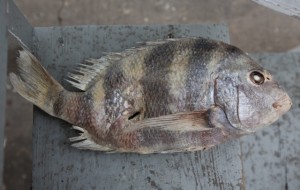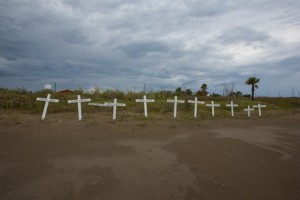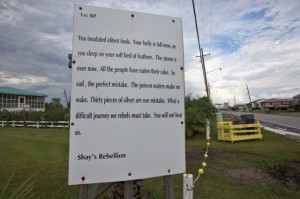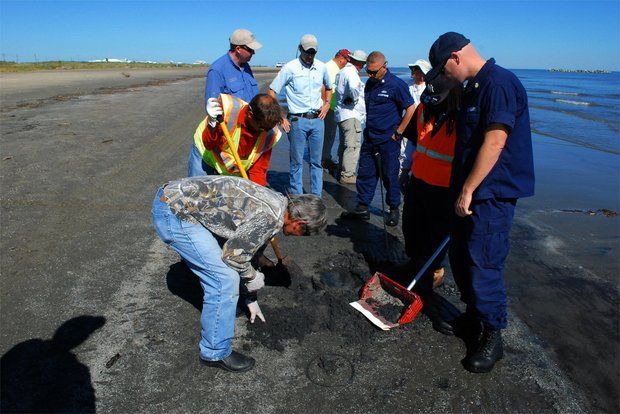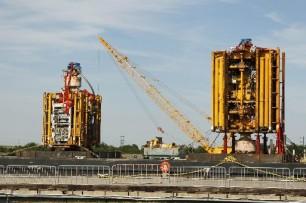Monday, 21 October 2013 09:29
By Dahr Jamail, Aljazeer
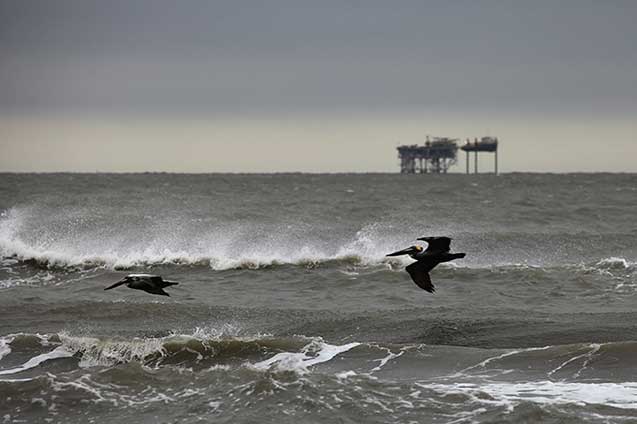
Three years after well blowout, declining seafood catches and deformities point to an environment in distress. (Photo: Erika Blumenfeld)
New Orleans – Hundreds of kilograms of oily debris on beaches, declining seafood catches, and other troubling signs point towards an ecosystem in crisis in the wake of BP’s 2010 oil disaster in the Gulf of Mexico.
“It’s disturbing what we’re seeing,” Louisiana Oyster Task Force member Brad Robin told Al Jazeera. “We don’t have any more baby crabs, which is a bad sign. We’re seeing things we’ve never seen before.”
Robin, a commercial oyster fisherman who is also a member of the Louisiana
Government Advisory Board, said that of the sea ground where he has harvested oysters in the past, only 30 percent of it is productive now.
“We’re seeing crabs with holes in their shells, other seafood deformities. The state of Louisiana oyster season opened on October 15, and we can’t find any production out there yet. There is no life out there.”
According to Robin, entire sectors of the Louisiana oyster harvest areas are “dead or mostly dead”. “I got 10 boats in my fleet and only two of them are operating, because I don’t have the production to run the rest. We’re nowhere near back to whole, and I can’t tell you when or if it’ll come back.”
State of Louisiana statistics confirm that overall seafood catch numbers since the spill have declined.
Over three million pounds of oiled material have been found in Louisiana this year. (Photo: Erika Blumenfeld / Al Jazeera)
Everything is down’
Robin is not the only member of the Gulf’s seafood industry to report bleak news. Kathy Birren and her husband own Hernando Beach Seafood, a wholesale seafood business, in Florida.
Shrimp with tumours continue to be found along the impact zone, from Louisiana to Florida. (Photo: Dean Blanchard)
“I’ve seen a lot of change since the spill,” Birren told Al Jazeera. “Our stone crab harvest has dropped off and not come back; the numbers are way lower. Typically you’ll see some good crabbing somewhere along the west coast of Florida, but this last year we’ve had problems everywhere.”
Birren said the problems are not just with the crabs. “We’ve also had our grouper fishing down since the spill,” she added. “We’ve seen fish with tar balls in their stomachs from as far down as the Florida Keys. We had a grouper with tar balls in its stomach last month. Overall, everything is down.”
According to Birren, many fishermen in her area are giving up. “People are dropping out of the fishing business, and selling out cheap because they have to. I’m in west-central Florida, but fishermen all the way down to Key West are struggling to make it. I look at my son’s future, as he’s just getting into the business, and we’re worried.”
Dean Blanchard, owner of a seafood business in Grand Isle, Louisiana, is also deeply troubled by what he is seeing. “We have big tar mats coming up on Elmers Island, Fouchon, Grand Isle, and Grand Terre,” Blanchard told Al Jazeera. “Every time we have bad weather we get fresh tar balls and mats.”
Blanchard said his business generates only about 15 percent of what it did before the spill. “It looks like it’s getting worse,” he said. “I told my wife when she goes to the mall she can only spend 15 percent what she used to spend.”
Blanchard has also seen shrimp brought in with deformities, and has taken photographs of shrimp with tumours (see above). Others lack eyes. He attributes the deformities to BP’s use of toxic dispersants to sink the spilled oil.
“Everybody living down here watched them spray their dispersants day in and day out. They sprayed our bays and our beaches,” he said. “We got a problem, because BP says they didn’t spray down here, but we had a priest that even saw them spraying. So either we got a lying priest, or BP is lying.”
BP and the Coast Guard have told the media they have never sprayed dispersants within 10 miles of the coast, and that dispersants have never been used in bays.
Eyeless shrimp, along with other seafood abnormalities, have become common in many areas along the Gulf Coast. (Photo: Erika Blumenfeld / Al Jazeera)
A decades-long recovery
On a more sombre note, Dr Ed Cake, a biological oceanographer and a marine biologist, believes it will likely take the Gulf decades to recover from the BP disaster.
“The impacts of the Ixtoc 1 blowout in the Bay of Campeche in 1979 are still being felt,” said Cake, referring to a large oil spill near the Mexican coast, “and there are bays there where the oysters have still not returned. My prediction is we will be dealing with the impacts of this spill for several decades to come and it will outlive me.”
According to Cake, blue crab and shrimp catches have fallen in Mississippi and Alabama since the spill, and he also expressed worries about ongoing dolphin die-offs. But his primary concern is the slow recovery of the region’s oyster population.
“Mississippi recently opened their season, and their oyster fisherman are restricted to 12 sacks of oysters a day. But they can’t even reach six,” Cake said. “Thirty sacks would be a normal day for oysters – that was the previous limit – but that is restricted now because the stocks just aren’t there.”
Cake’s conclusion is grim. “Here in the estuarine areas, where we have the oysters, I think it’ll be a decade or two before we see any recovery.”
BP previously provided Al Jazeera with a statement on this topic, a portion of which read: “Seafood from the Gulf of Mexico is among the most tested in the world, and, according to the FDA and NOAA, it is as safe now as it was before the accident.”
BP claims that fish lesions are naturally common, and that before the spill there was documented evidence of lesions in the Gulf of Mexico caused by parasites and other agents.
More oil found
The second phase of the ongoing federal trial against BP investigates whether the company’s actions to halt the flow of oil during the blowout were adequate, and aims to determine how much oil was released.
“BP is mounting an aggressive legal and public relations campaign to shield itself from liability and minimise the amount of oil spilled in the Gulf, as well as the ongoing impacts from the disaster,” said Jonathan Henderson, an organiser for the Gulf Restoration Network, an environmental group.
Even Louisiana’s Republican Governor Bobby Jindal agrees. Jindal recently said, “Three and a half years later, BP is spending more money – I want you to hear this – they are spending more money on television commercials than they have on actually restoring the natural resources they impacted.”
As far away from the blowout site as Florida, researchers continue to find oil in both Tampa Bay and Sarasota Bay.
In Louisiana, according to the LA Coastal Protection and Restoration Authority (CPRA), more than 200 miles of shoreline have “some degree of oiling”, including 14 miles that are moderately or heavily oiled. From March through August of this year, over three million pounds of oiled material have been collected in Louisiana, more than double the amount over the same time period last year.
In addition, the CPRA reports that “investigations into the chemical composition of MC252 [BP’s Macondo well] oil samples demonstrate that submerged oil is NOT substantially weathered or depleted of most PAH’s [polycyclic aromatic hydrocarbons],” and “disputesŠfindings relied on by the USCG [US Coast Guard] that Deepwater Horizon oil is non-toxic”.
The agency also expresses concerns that “submerged oil may continue to pose long term risk to nearshore ecosystems”.
“New impacts to the Gulf’s ecosystem and creatures also continue to emerge,” Henderson told Al Jazeera. “This year alone, the National Marine Fisheries Service has recorded 212 dolphins and other marine mammal standings in the northern Gulf. A new scientific study conducted by NOAA, BP and university researchers also shows significant negative impacts on tiny organisms that live on the sea floor in a 57 square mile area around the Deepwater Horizon well site.”
Numerous other impacts have been documented since the disaster began, including genetic disruptions for Gulf killifish, harm to deepwater corals,, and the die-off of tiny foraminifera that are an important part of the Gulf’s food chain.
Ongoing studies continue to reveal toxins from BP’s spill in water, soil, and seafood samples.
Meanwhile, fishermen in BP’s impact zone wonder if things will ever return to normal. “Our future is very, very dim, and there are no sponge crabs out there, which is the future,” Robin concluded. “I’ve never seen this in my lifespan. I’m not seeing a future, because everything out there is dead.”
Special thanks to Richard Charter
